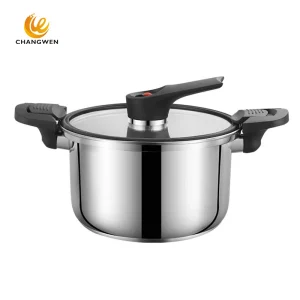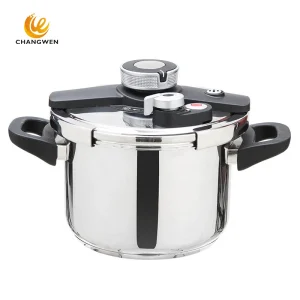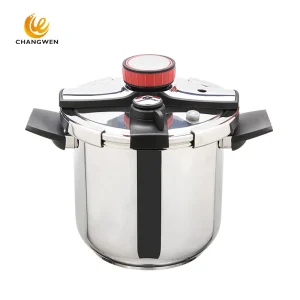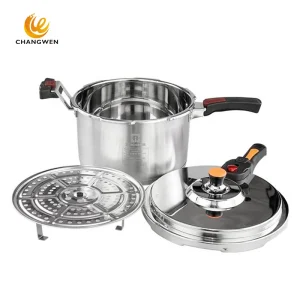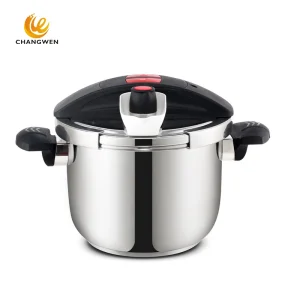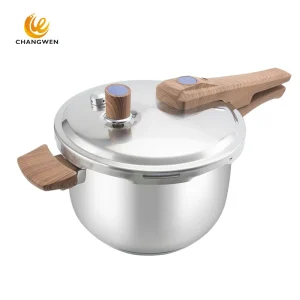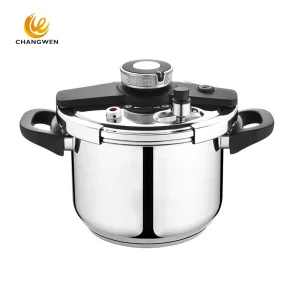Pressure Cooker Manufacturer
Changwen pressure cooker has three-layer composite bottom and symmetrical heat conduction. The pot body is made of 304 food grade stainless steel, one-piece molding, and good sealing. The maximum pressure in the pot is 90kpa, which can make beef and pork feet soft and tender, and melt in your mouth. Six-layer safety protection and longer service life. Suitable for various gas stoves, induction cookers, electric ceramic stoves, etc.
Home > Pressure Cooker
Changwen Pressure Cooker
Pressure cookers are commonly shaped like sealed lid, screw lid and pressure lid according to the lid type. Made of aluminum alloy or stainless steel. Capacity 3L-15L, various specifications. Single bottom for open flame. Suitable for induction cooker, electric ceramic stove and other stoves
The pressure value is 50kPa/120kPa, and the working temperature is 110~120℃. The general pressure value of 70KPa has met the needs of families.
304 Tri-ply stainless steel encapsulated base 5L save time quick micro pressure cooker pot China Factory CW-PC06
4.0/6.0/9.0L Stainless steel Pressure Cooker CW-PC014
6.0L 304 Stainless Steel Pressure Cooker CW-PC015
European Style High Quality Stainless Steel pressure pot Pressure Rice Cooker for Kitchen CW-PC05
Factory Sale low pressure cooker stainless steel pressure cooker cookware OEM CW-PC011
Hot sale 304 stainless steel Pressure cooker 4L6L7L8L Pressure cooker Newest style high grade large CW-PC03
Hot sale Pressure Cooker Save time Eletronic Pressure cooker Cookware Manufacturer CW-PC020
Large Capacity 304 stainless steel pressure cooker Eletronic pressure cooker made in China CW-PC013
Why Choose Changwen Pressure Cooker?
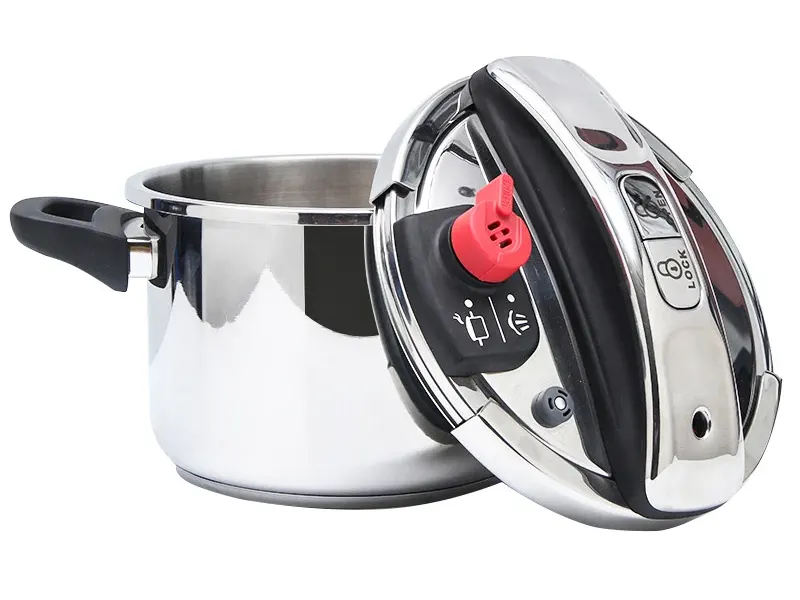
Thickened 304 stainless steel, high-quality materials for making pots
90KPa has double safety valves, the pressure cooker is one-piece, and has good sealing
Dual card lock lid design, one-handed opening and closing of the lid 90 degrees, turn to open the lid
Six-fold safety protection, easy to use, durable
Not picky about stoves, electric stoves, electric ceramic stoves, gas stoves and induction cookers can be used
Meet Changwen Pressure Cooker
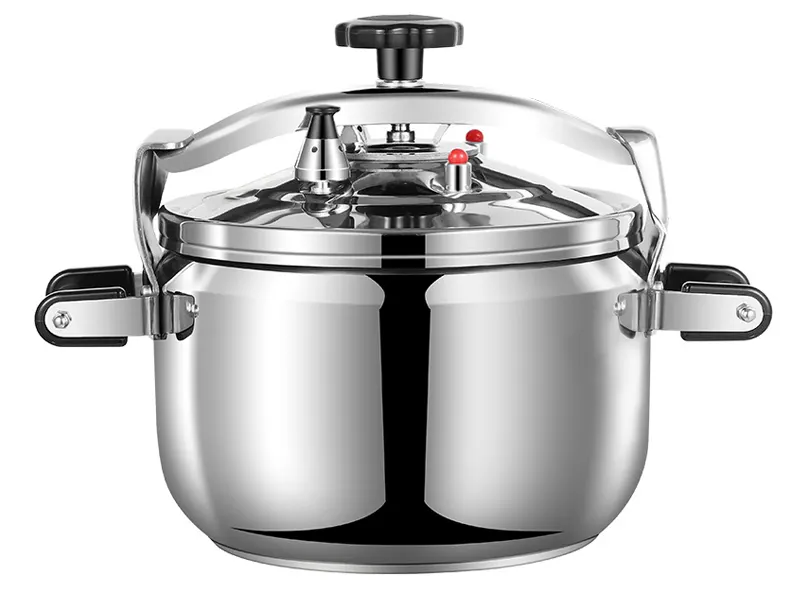
Commercial large capacity double safety valve knob type open lid stainless steel pressure cooker
Commercial large capacity double safety valve knob-type stainless steel pressure cooker
304 stainless steel, one-piece forging, pot body thickness of about 1.3mm, lid thickness of about 1.0mm, extra thick pot body durable.
8L to 50L large capacity, can meet home and commercial cooking.
Double safety lock, six-fold protection for more peace of mind.
Knob-type lid opening is more convenient.
50kpa high pressure stewing is 50% faster than ordinary soup pots.
Composite bottom is suitable for gas stoves, electric ceramic stoves, halogen stoves, induction cookers.
Suitable for soup, porridge, stew, and stew pot.
304 Stainless Steel Micro Pressure Cooker
304 stainless steel is safe and reliable. One pot can be used for multiple purposes, it can be a pressure cooker or an ordinary soup pot.
When working at micro pressure, the pressure is lower than 1.2 atmospheres, which is about 10 to 20 minutes faster than ordinary soup pots to cook food.
The convenient lock lid is easy to operate and open and close freely, and the bakelite handle is non-slip and non-scalding.
The thickened pot bottom is sturdy and durable.
The visible pot lid makes delicious cooking visible. The pot lid can be designed to stand up.
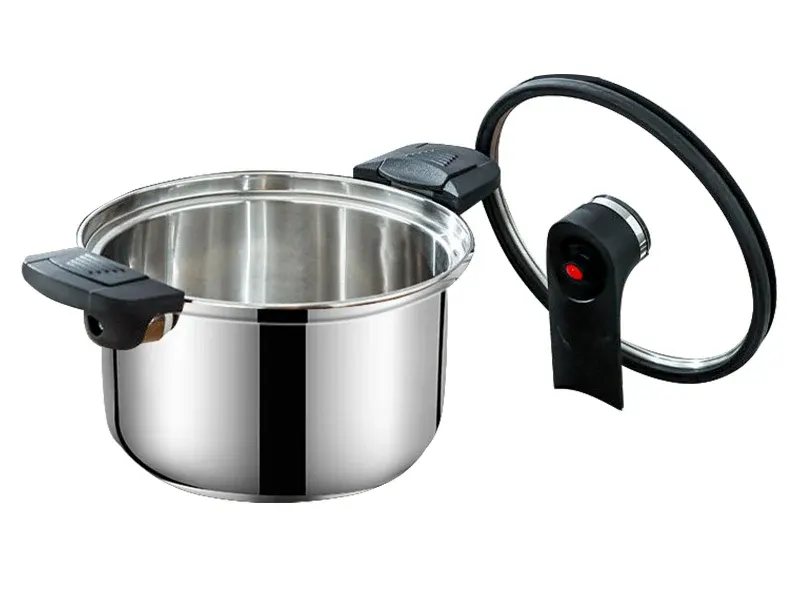
Pressure Cooker FAQ
A pressure cooker is a sealed pot with a valve that controls the steam pressure inside. As the pot heats up, the liquid inside forms steam, raising the pressure and temperature, which cooks food faster than conventional methods.
A pressure cooker increases the temperature of boiling water and steam, allowing food to cook at higher temperatures. The sealed environment traps steam, which increases the internal pressure and speeds up the cooking process.
You can cook a wide variety of dishes in a pressure cooker, including:
Meats and stews
Beans and legumes
Rice and grains
Vegetables
Soups and broths
Pasta dishes
Desserts like puddings and cheesecakes
There are generally two methods for releasing pressure:
Natural Release: Let the pressure decrease on its own over time, which usually takes about 10-20 minutes.
Quick Release: Manually release the pressure using the valve on the lid, which takes a few minutes. Be careful of the hot steam!
Most pressure cooker recipes require at least 1 cup (240 ml) of liquid to generate steam. Always check the minimum liquid requirement stated in your pressure cooker’s user manual.
Most parts of a pressure cooker are dishwasher-safe, excluding the base of an electric pressure cooker. Remove the sealing ring and clean it separately. Always consult your user manual for specific cleaning instructions.
When using a pressure cooker, the amount of food should not exceed two-thirds of the inner pot. This is because foods that easily expand and overflow the pot, such as rice and beans, can easily block the exhaust valve when boiling, resulting in poor exhaust and increasing the risk of explosion.
1. Check if the safety valve is loose. If the safety valve is loose, pressure cannot be accumulated and the pressure cooker cannot be pressurized.
2. Check if the sealing ring is loose or damaged. If the sealing ring is loose or damaged, pressure cannot be accumulated and the pressure cooker cannot be pressurized.
3. Check if the obstruction is cleaned. If there is debris or dirt inside the pressure cooker, it will affect the normal circulation of steam and prevent pressure from accumulating.
1. Check if the safety valve is loose. If the safety valve is loose, the pressure cooker cannot release pressure. At this time, you can try to gently tap the safety valve to return it to its normal position.
2. Check if the sealing ring is damaged. If the sealing ring is damaged, the pressure cooker cannot release pressure. At this time, the sealing ring needs to be replaced.
Get a cookware catalog?
WE’RE HERE TO HELP. 24 HOURS A DAY, 7 DAYS A WEEK.


